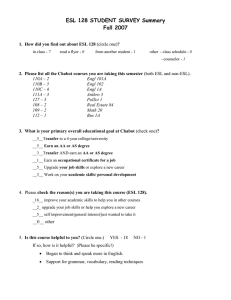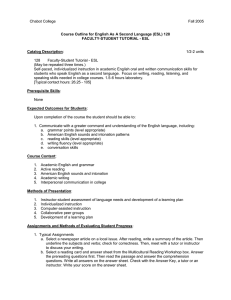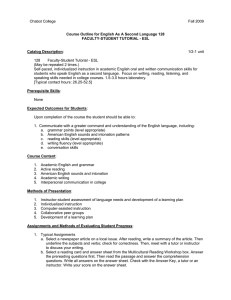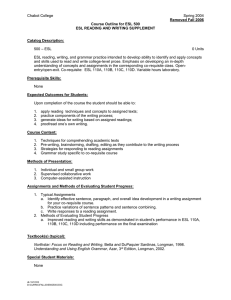College of San Mateo Course Outline
advertisement
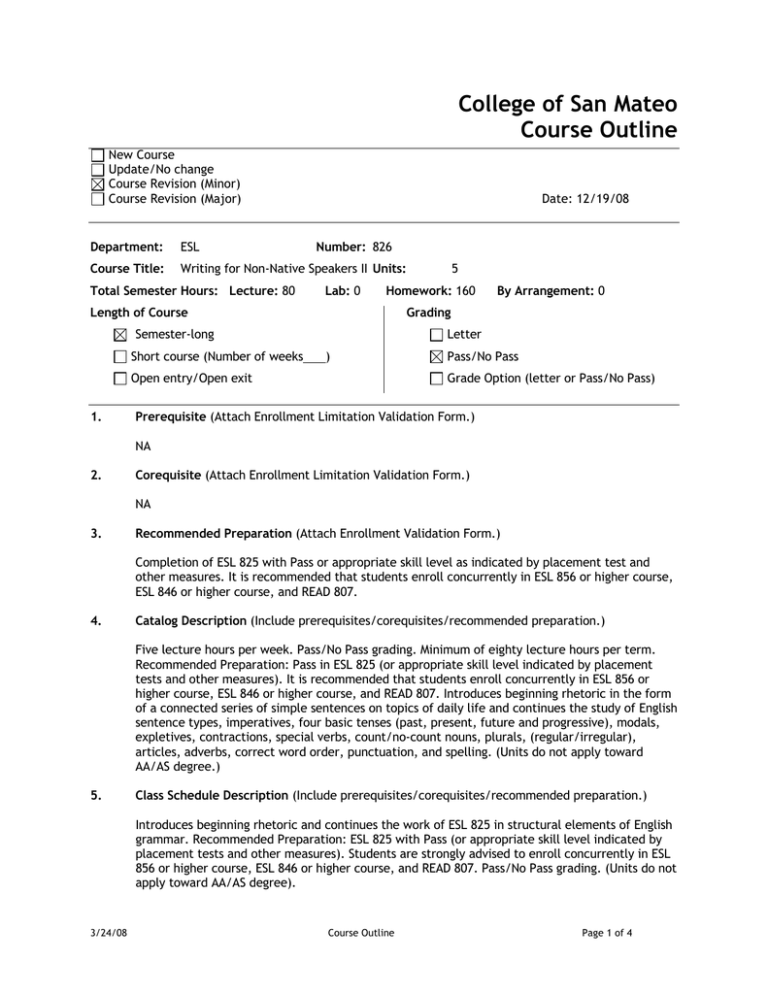
College of San Mateo Course Outline New Course Update/No change Course Revision (Minor) Course Revision (Major) Date: 12/19/08 Department: ESL Course Title: Writing for Non-Native Speakers II Units: Total Semester Hours: Lecture: 80 Number: 826 Lab: 0 Homework: 160 Length of Course Letter ) Open entry/Open exit 1. By Arrangement: 0 Grading Semester-long Short course (Number of weeks 5 Pass/No Pass Grade Option (letter or Pass/No Pass) Prerequisite (Attach Enrollment Limitation Validation Form.) NA 2. Corequisite (Attach Enrollment Limitation Validation Form.) NA 3. Recommended Preparation (Attach Enrollment Validation Form.) Completion of ESL 825 with Pass or appropriate skill level as indicated by placement test and other measures. It is recommended that students enroll concurrently in ESL 856 or higher course, ESL 846 or higher course, and READ 807. 4. Catalog Description (Include prerequisites/corequisites/recommended preparation.) Five lecture hours per week. Pass/No Pass grading. Minimum of eighty lecture hours per term. Recommended Preparation: Pass in ESL 825 (or appropriate skill level indicated by placement tests and other measures). It is recommended that students enroll concurrently in ESL 856 or higher course, ESL 846 or higher course, and READ 807. Introduces beginning rhetoric in the form of a connected series of simple sentences on topics of daily life and continues the study of English sentence types, imperatives, four basic tenses (past, present, future and progressive), modals, expletives, contractions, special verbs, count/no-count nouns, plurals, (regular/irregular), articles, adverbs, correct word order, punctuation, and spelling. (Units do not apply toward AA/AS degree.) 5. Class Schedule Description (Include prerequisites/corequisites/recommended preparation.) Introduces beginning rhetoric and continues the work of ESL 825 in structural elements of English grammar. Recommended Preparation: ESL 825 with Pass (or appropriate skill level indicated by placement tests and other measures). Students are strongly advised to enroll concurrently in ESL 856 or higher course, ESL 846 or higher course, and READ 807. Pass/No Pass grading. (Units do not apply toward AA/AS degree). 3/24/08 Course Outline Page 1 of 4 6. Student Learning Outcomes (Identify 1-6 expected learner outcomes using active verbs.) Upon successful completion of the course, the student will be able to: 1. write an academic paragraph with reasonable development, organization, mechanics, and level appropriate vocabulary. 2. use low-intermediate grammar structures appropriately in academic paragraphs. 7. Course Objectives (Identify specific teaching objectives detailing course content and activities. For some courses, the course objectives will be the same as the student learning outcomes. If this is the case, please simply indicate this in this section). same as student learning outcomes above 8. Course Content (Brief but complete topical outline of the course that includes major subject areas [1-2 pages]. Should reflect all course objectives listed above. In addition, you may attach a sample course syllabus with a timeline.) SLO 1. Students will write several academic paragraphs both in class and out of class. Model paragraphs representing various rhetorical modes (e.g. descriptive, narrative, illustrative, and process) will be read and analyzed. Sudents will learn to approach academic writing as a process. Students will practice brainstorming to develop ideas; creating outlines to organize ideas; using inner paragraph transitions and other signals to enhance fluency; proofreading ,editing and revising to find grammar and mechanical errors and to improve development and organization. Students will practice creating appropriate topic and concluding sentences. Paragraph coherence will be practiced. Out of class writing assignments will involve multiple drafts. SLO 2. Students will be taught various grammar structures in connection with writing assignments, and students are required to make use of these structures in their writing assignments. The grammar structures shall include; 1. affirmative, negative, and question forms for all tenses listed below; 2. simple present tense with adverbs of frequency, 3. present continuous, 4. simple past (including irregulars), 5. future (both forms), 6. modals, 7. "be" with expletives "it" and "there," 8. contractions with "be" and "do," "does," and "did," 9. verbs plus infinitives: "going to," "have to," "like to," "want to," and "need to," 10. count/non-count nouns with quantity words; some, any, much, many, a lot of, 11. irregular nouns, 12. articles, 13. pronouns: subject, object, possessive, demonstrative, 14. prepositions of time and place, 15. prepositional phrases, 16. adjectives: possessive, colors, descriptors, 17. imperatives. 3/24/08 Course Outline Page 2 of 4 9. Representative Instructional Methods (Describe instructor-initiated teaching strategies that will assist students in meeting course objectives. Include examples of out-of-class assignments, required reading and writing assignments, and methods for teaching critical thinking skills.) If hours by arrangement are required by this course, indicate the additional instructional activity which will be provided during this time. There will be lectures, class discussions, readings, whiteboard work, in-class work, out-of-class work, student-instructor conferences, small group work, exercises in comprehension and vocabulary. Teaching strategies that will assist students in meeting course SLOs include but are not limited to the following: 1. Using inductive methods to elicit students' prior experience and knowledge of a topic to be dealt with in a writing assignment; 2. Using student-centered activities that enable students to discover what they already know about a topic; 3. Using lectures along with demonstrations of grammatical structures; 4. Using inductive methods to elicit students' prior knowledge of the target grammar structure; 5. Using reading materials to build schema for writing assignments; 6. Using reading materials--both published and student generated--to focus on rhetorical structures as well as exemplary sentences; 7. Using sentence combining to help students develop syntactical sophistication; 8. Using journal assignments written both inside and outside of class to help students develop fluency in writing; 9. Using error logs or similar record-keeping tables to encourage students to be accountable for correcting their own grammatical errors before submitting work to be graded; 10. Conducting in-class editing workshops to help students identify their own errors; 11. Using Peer-Review sheets to help students develop the ability to help their classmates improve as writers and to help them develop an awareness of audience. 10. Representative Methods of Evaluation (Describe measurement of student progress toward course objectives. Courses with required writing component and/or problem-solving emphasis must reflect critical thinking component. If skills class, then applied skills.) Students are graded on their performance in the following types of course work: Quizzes, writing assignments written outside of class (paragraphs that have gone through multiple drafts), writing assignments written in class (timed writing assignments), and the final examination. Other types of work that may be evaluated are homework, journals, answers to study questions, and class participation. A possible formula for determining course: Quizzes 20% Writing Assignments 45% Homework 05% Participation 05% Journal 05% Final Examination 20% 3/24/08 Course Outline Page 3 of 4 11. Representative Text Materials (With few exceptions, texts need to be current. Include publication dates.) 1. Blanton, Linda Lannon. Composition Practice, Book 2 3rd edition. Heinle & Heinle, 2001 2. Oshima, Alice & Hogue, Anne. Introduction to Academic Writing. Pearson ESL, 2006 3. Azar, Betty. Fundamentals of English Grammar, Vol. A. Prentice Hall, 1999 4. Cisneros, Sandra. House on Mango Street. Vintage Books, 1984 5. Butler, Linda. The ESL Companion to House on Mango Street. McGraw Hill, 1996 Prepared by: (Signature) Email address: Submission Date: 3/24/08 Course Outline Page 4 of 4
